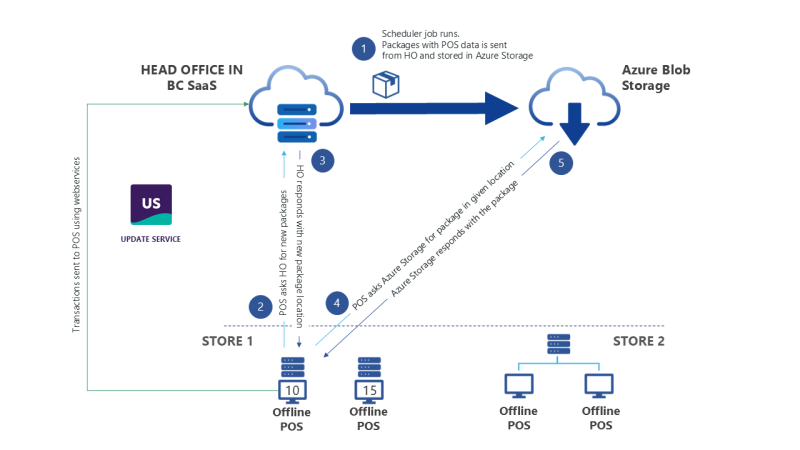
The simplified Offline POS using Azure Storage replication is a pure SaaS solution that lets you run offline POS without Data Director and Hybrid Component Server.
Although it is not a requirement, we recommend that you always use Update Service to create the offline POS. This makes the POS maintenance easier when you roll out updates to the POSs.
The setup relies on Update Service to create the offline POS and roll out version updates to the POSs.
Note: Update Service must be hosted on-premises or on an Azure VM.
The Scheduler runs in Head Office in SaaS and Web Replication using Azure Storage is used to push master and setup data updates to the offline POS.
POS or Store are running fully offline, and the same as with the old Hybrid server there is online functionality with Web Service Requests.
Offline POS database
This deployment option guarantees optimal POS uptime, as it only relies on local resources. This setup is the most complex and the heaviest in terms of maintenance, as you must install all components on every POS. You are also responsible for keeping all databases up to date on the newest version.
Store environment
- POS runs: SQL database, Service Tier, Data Director, and BC Client.
- POSs are resilient and do not need a network to operate.
- Store backoffice users will connect to HQ with a modern Web client.
Offline POS server database
The POS is connected to the Offline POS Server database using the web client. The POS require minimum component installation, and you only need to keep one database per store up to date on the newest version.
Offline POS Server Database – Why?
In general, there is no need for a specific POS Server if the client is running resilient POSs with both database and service tier installed. But if the client is running pure browser-based hardware on the POSs, you need a POS Server in the store (on the LAN) to run the database tier – Microsoft SQL Server, Service Tier – Microsoft Dynamics 365 Business Central Service Tier, and LS Retail Hardware Station.
Store environment
- POS Server that hosts: SQL database and Service Tier.
- POSs only run client, modern web client, and connect to the POS Server.
- POSs are reliant on the LAN in the store works, and they have access to the Store Server always.
- Store backoffice users will connect to HQ with a modern Web client.
Dataflow
- The Offline POS or the Offline POS server calls Head Office in SaaS to inquire if packages are waiting, and subsequently pulls down the packages from Azure Storage.
- Sales Transactions are pushed from POS Servers to HQ after each sale using POS web services.
- Web services used for online requirements (inventory lookup, voucher validation, and so on).